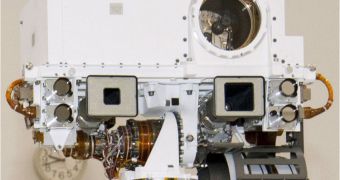Researchers at the University of Indiana in Bloomington are extremely proud to see two of their instruments ready to launch aboard the Mars Science Laboratory (MSL) rover Curiosity. The spacecraft is scheduled to take off on Saturday, November 26.
Curiosity is one of the most advanced spacecraft ever created, and definitely the most complex Mars-bound spacecraft ever. It features a monumental suite of 10 high-tech scientific instruments, on which experts rely for clearing out Mars' past climate.
Two of these instruments, called the Chemistry & Mineralogy X-Ray Diffraction/X-Ray Fluorescence Instrument (CheMin) and the Mars Hand Lens Imager (MAHLI), represent UI's contribution to this extremely ambitious space exploration program.
Indiana experts competed against a large number of other research teams for the opportunity to construct instruments for the MSL mission back in 2004. At the time, NASA selected MAHLI and CheMin for further investigation, and the instruments eventually stuck.
Two days from now, they are scheduled to depart for Mars aboard an Atlas V rocket, from the Cape Canaveral Air Force Station (CCAFS), in Florida. Indiana University geologists are eagerly anticipating a successful launch, and a safe arrival at the Red Planet.
Once in Gale Crater, CheMin – a powder X-ray diffraction instrument – will be used to identify and quantify whatever minerals may be present in the rocks and soil Curiosity samples. The goal will be to determine if water was involved in the formation of these minerals.
It will also search the same samples for other telltale signs that life once existed on Mars, or that at least conditions for its emergence were right at some point in the planet's troubled history. NASA Ames Laboratory expert David Blake is the principal investigator of the instrument.
On the other hand, MAHLI is a focusable color camera, which is installed on a high-mobility turret on the tip of Curiosity's robotic arm. It is perfectly capable of acquiring HD images of whatever target it's pointing at. The photos have a level of detail and resolution similar to that of consumer cameras.
Malin Space Science Systems (MSSS) geologist Ken Edgett will be the principal investigator of the instrument. This company constructed numerous cameras for previous NASA missions, and was called upon again for Curiosity.
With these capabilities and more, MSL is bound to make a world of difference if it can land on Mars properly. A lot hangs in the balance here, since the landing system NASA will use – the Sky Crane – has never seen action before.

 14 DAY TRIAL //
14 DAY TRIAL //